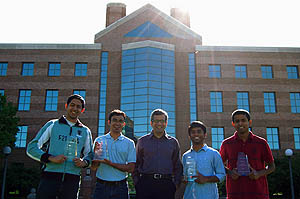Qualcomm Cognitive Radio Contest on Wireless Microphone Detection

Qualcomm contest winners (from left) Sreeram Kannan, Adnan Raja,
Professor Venu Veeravalli (faculty adviser), Sreekanth Annapureddy,
and Jayakrishnan Unnikrishnan.
(Reprinted with kind permission from Spectral Holes: A blog on Cognitive Radio
by Gonzalo Vazquez Vilar, a doctoral student at University of Vigo, Spain)
A group of students of the ECE Illinois won the 2010 Qualcomm Cognitive Radio Contest. While the 3rd Smart Radio Challenge consisted in developing an integral framework for detection and tracking of different radios on an emergency scenario, the 2010 Qualcomm Cognitive Radio Competition required students to develop and implement algorithms that detect wireless microphone signals within a spectrum band.
While detecting digital television signals using the ATSC (American standard for digital television broadcasting) is not a big deal (given their embedded pilot tones), detecting 200 KHz wide wireless microphone signals with the detection performance required by the FCC proposal becomes a challenge. Qualcomm provided the different teams with training data, consisting on both signal sets with a wideband of 6 MHz and information on the frequencies where microphone signals were located. Contestants had to use this data to find a fitting model for the microphone signals and develop algorithms to detect them. The algorithm was judged based on its performance, novelty and implementation complexity.
The approaches followed by the 14 participating teams were fairly different. For example, the ECE Virginia Tech team:
The students developed a fairly robust solution. They determined a baseline noise correlation matrix from a data set with no wireless microphone signals. To see if a signal is present in a new environment, they compare the new correlation matrix with the baseline matrix using singular value decomposition. If their algorithm determines there is a signal, it calculates the center frequency from the measured auto correlation of the signal."
The winning team (ECE Illinois), advised by V. V. Veeravalli, commented that the key problem was learning to distinguish wireless microphone signals from narrowband interference caused by other electrical devices. They addressed this problem by characterizing the unique features of this narrowband interference.
The University of Illinois at Urbana-Champaign’s website added:
The Qualcomm contest requires students to develop an algorithm and software that detects if a wireless microphone signal is present within a spectrum, so the cognitive devices can avoid causing interference to it. The wireless microphone needs to be protected from interference as it holds the primary license for that spectrum.
However, finding the wireless microphone signals proved harder than they imagined. Raja said that Qualcomm provided the contestants with “training data,” which specified the frequencies where microphone signals were located. Contestants were expected to use this information to learn models and develop algorithms to classify the signals.
“The spectrum they provided was six megahertz wide, but the wireless microphone signal is very narrow, less than 200 kilohertz wide, and it can be anywhere in the spectrum, which makes it hard,” Unnikrishnan said.
“It’s like finding a needle in a haystack,” Raja added. “It’s so narrow, and it can be anywhere in the spectrum.”
Kannan said the key problem was learning to distinguish wireless microphone signals from unintended narrowband interference caused by electrical devices in the vicinity.
"We solved this by identifying features that characterize narrowband interference," Kannan said.
The algorithm was judged based on its performance, novelty and implementation complexity.
“We needed to keep in mind its practical applications, which was hard because we’re used to working with the theoretical,” Kannan said.
The group persisted and developed a strong, unique algorithm that classified signals with good confidence levels, which contributed to their win. If implemented into Qualcomm applications, their algorithm could help target open bandwidth and channel it into use.
“One potential application of cognitive radios is to bring high speed Internet to rural areas where it’s not presently available,” Raja said.
The winning students look forward to the future of their research.
“I think it’s very impactful in this sense. These kinds of competitions help us connect theory to practical applications and even guide futuristic research,” Kannan said. “It makes it all exciting.”



![Validate my RSS feed [Valid RSS]](valid-rss-rogers.png)

